Baroque (c. 1600 - 1720)
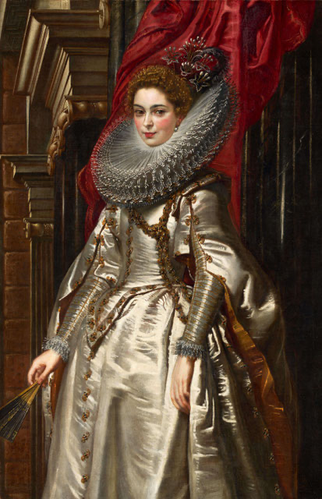
“Barocco“ (Portugese, English: uneven, odd) describes a pearl of irregular shape and was introduced retrospectively to describe the style of the 1600s in a negative light. In the Baroque era, the clear forms and unity of the preceding Renaissance was not wholly abandoned but changed into a more flourishing style. The dominant power that Spain had had in the preceding epochs, especially in the 16th century faded slowly. The Baroque era was a rather troubled one for Europe with The Thirty Year's War, the counter-reformation and rising absolutism. A very small nation, however, began to rise: The Netherlands remained in mostly untouched by the Thirty Years' War and became an economical and commercial power to reckon with Legal changes allowed unmarried women to have financial powers and engage in trade and business.
Clothing underwent radical changes, beginning in the geometric, sculptural style of the Renaissance and gradually shifting to much softer styles and silhouettes with flowing skirts and draped bodices and sleeves. Rubens' portrait of the Marchesa Brigida Spinola Doria dating to 1606 shows her in a steely silver dress with long, curved stomacher, a full skirt, giant ruff and utterly wrinkle-free padded sleeves that imitate body armour.
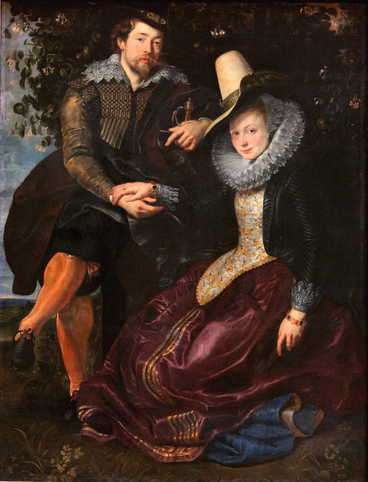
In the low countries, trading connections grew the wealth of an expanding middle class. This was reflected in fashion. Rubens painted himself with his wife Isabella in 1609. She is wearing a distinctive style of dress with a fitted bodice with a very long stomacher, much like that of Marchesa Brigida
Sinola Doria. She is wearing a blue skirt under a red silk skirt trimmed with gold braid.
Her huge millstone ruff is carefully starched and edged with expensive lace. On the top of her head sits a high and broad-brimmed hat, in a rather masculine style as was the fashion at the time. Isabella's sleeves are long, tight and end in fine linen cuffs. Around each wrist she wears a golden bracelet set with gemstones. There is still a lot of Elizabethan era dress in this with the very long stomacher. In the decades to come, fashion would become softer and more flowing. A considerable change was, however, the elimination of the Elizabethan farthingale in favour of hip padding. Consequently, the skirts fell softer and the whole silhouette appeared less geometric and more flowing. Ladies wore a mass of underskirts, made of as fine fabrics as could be afforded.
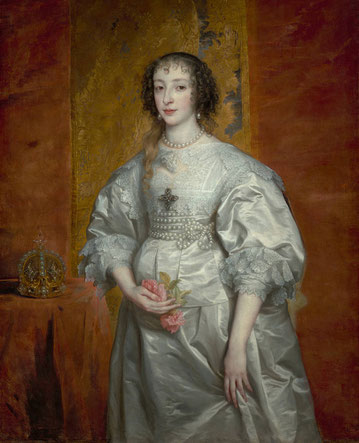
The cut of the sleeves widened and in many cases shortened. Lace or linen cuffs were added to every kind of sleeve. In the 30s and 40s of the 17th century, the female fashion was comparatively flowing and natural, as portraits from the ladies at the English court attest. The skirts were moderately wide and the bodice was short, close-fitting and low-cut.
The neckline was square-cut or baring the shoulders like a wide Carmen neckline. The ruff collar remained until it changed to a cape-like collar of fine(st) lace in the United Kingdom and elsewhere by the 1630s, called Vandyke collars. Queen Henrietta Maria and her courtiers wore unpatterned but lush silk fabrics, letting their luxurious sheen dictate the overall look of the garments.
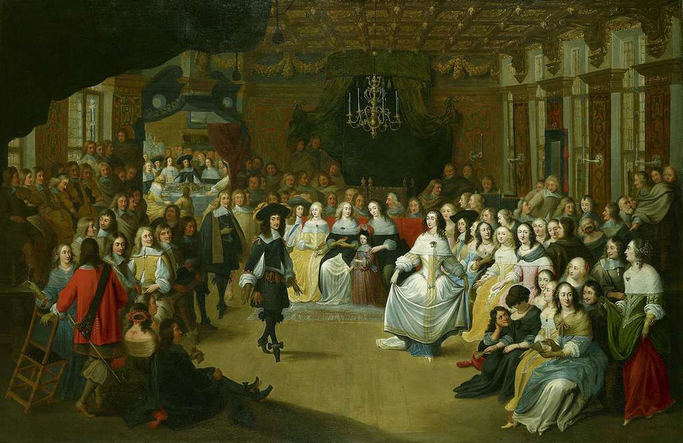
As the decades went on, the waistline drops again and the long pointed waist that remains far into the 1700s comes into
fashion. Hieronymus Janssen's "Charles II Dancing at a Ball at Court" shows this excellently. This silhouette increasingly resembles two triangles meeting at the tip - one inverse formed by the shoulders to the waist, and one from the waist down to the wide skirt hem. The changing cut of the
dress is accentuated by the placement of braid which highlights these lines.
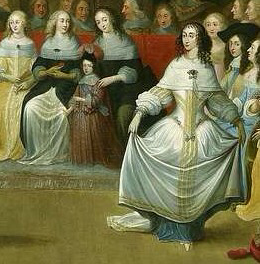
The sleeves are wide and puffy, ending in at the wrist or below the elbow in lace cuffs or linen ruffles. Fashionable was furthermore to wear sleeves cut in the virago style: loose-fitting sleeves held in place by colourful ribbons which sectioned the wide sleeves into smaller puffs down the arms. Soft colours and pastel shades can be frequently seen in the portraiture and art of the this time.
Do you wish to own or gift a piece of history? Now in my etsy-shop:
Accessories:
Accessories depended on the season, the region, the decade, and the wealth and social rank of a person. Purses were important
accessories to hold money and small personal belongings. Belts served to carry accessories such as small knives or sewing tools on, or to tuck up the wide skirts into.
Fans were used to cool oneself while in winter stoles, fur muffs, hoods and full face masks were worn against the bitter cold. Face masks, which feature prominently in the Baroque artwork around
the Venetian carnival, were often round and covering most of the face except for the eyes and nostrils, tied around the head with strings or kept on by biting on a button on the inside. The
wearer had to hold this button firmly between their front teeth to keep the mask in place and was thus unable to speak with the mask on, adding to the carnival mystique.
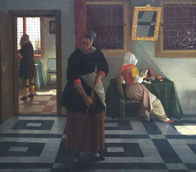
Shoes:
The heel lost nothing of its popularity and was worn by both men and women. The toe-caps were usually pointed or gently curved. The shoes were often closed with a buckle, tied with a ribbon, or were just mules slip in. Those who could afford it had the shoes made of fine materials like high-quality leather, velvet or damask. Pattens were a type of overshoe which was worn outside to protect the fine footwear from mud and dirt on the streets. Wooden clogs were the footwear of the lower members of society working in fields or in the streets. This painting - Interior with Painter, Woman Reading and Maid Sweeping by Pieter Janssens Elinga, c. 1665 to 1670 - shows three different pairs of shoes. The sitting lady wears fine red slippers and the maid has sturdier, simpler, dark footwear. The man in the background has heeled shoes tied with black ribbons.

Beauty:
Contrary to common belief, people bathed regularly provided they could afford it, or washed at least. Yet, the overall state
of houses and towns without a proper sewage system, as well as the sketchy knowledge in all things medical allowed epidemics to spread. The pox epidemics were particularly merciless, killing
numerous people and leaving the survivors with scars. To cover them, make-up and decorative little plasters called 'mouches' were used. High quality face make-up was unfortunately made from lead
(Ceruse) and its toxicity was well known although it did not stop the fashionable set from applying it.
Nonetheless, it is an enduring cliché that powdered wigs and faces white with make-up are characteristic of the Baroque era.
This was by no means the case, powdered wigs would not come up until the Rococo era. Make-up was used. but generally sparingly. Visual and written sources tell us that most people presented with
a fresh, natural look.

Hair:
There are a multitude of Baroque hairstyles, with each region and decade furnishing different hair-dos. In general, many paintings from this era depict styles with up-dos accompanied by soft curls framing the face.
The hairstyles worn by Queen Henrietta Maria are very similar to the hairstyles of Renaissance Florence some 150 prior - featuring fine curls around the top section of the hair tightly pulled back.
Hair remained a surface for sculpting and for displays of wealth, power and taste. In the final years of the 1600s, hairdos became higher. In Versailles, wire bases, padding and hair-pieces were used to create voluminous height.
Jewellery:
Plain fabrics were naturally a great base for elaborate jewellery of gems and precious metals. The techniques of gem-cutting had advanced so that the luster and light refraction was better and the stones glittered more beautiful. Jewellery was precious and important as sentimental tokens of family remembrance, and identity. Pieces were gifted for baptisms, weddings, births and later handed down. Rings as tokens of love and marriage were omnipresent in society, simpler or elaborate as personal circumstances allowed. Healing powers were attributed to jewels and particular gems worn against the skin believed to have positive influences on the body.
Pearls remained very popular throughout the early modern era and were handed down in families. Elisabeth Stuart, who married
the Elector of the Palatinate and moved to Heidelberg, Germany, is portrayed with magnificent lengths of pearls which she must have got from her mother Anne of Denmark who was also portrayed
wearing them.
With the lengthening of the waist and the increasing v-shape of the bodice cut, ornaments to accentuate this became fashionable. Brooches arranged down the centre front of the bodice, or special
bodice ornaments called "devant le corsage" can be observed in paintings and as jewellery in museum collections (Bayrisches Nationalmuseum in Munich has a magnificent devant-de-corsage in
its collection, for example). Some pieces were crafted with gems sitting on hairsprings fixed to the ornament which then moved and glittered at every motion of the wearer.
Patterns:
Nehelenia Patterns np800 1660s Gown Pattern
- Please note that this list does claim no completeness and does not operate as advertisement. It was merely composed for informative purposes. Furthermore, no valuation of the patterns is implied or intended -
© Epochs of Fashion






